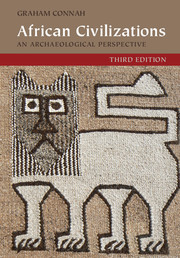Book contents
- Frontmatter
- Dedication
- Contents
- List of figures
- Preface and acknowledgements
- 1 The context
- 2 Origins: social change on the lower Nile
- 3 The Mediterranean frontier: North Africa
- 4 Sudanic genesis: Nubia
- 5 Isolation: the Ethiopian and Eritrean Highlands
- 6 Opportunity and constraint: the West African savanna
- 7 Achieving power: the West African forest and its fringes
- 8 Indian Ocean networks: the East African coast and islands
- 9 Cattle, ivory, and gold: social complexity in Zambezia
- 10 Central Africa: the Upemba Depression, Interlacustrine Region, and Far West
- 11 Settlement growth and emerging polities: South Africa
- 12 What are the common denominators?
- References
- Index
12 - What are the common denominators?
Published online by Cambridge University Press: 05 November 2015
- Frontmatter
- Dedication
- Contents
- List of figures
- Preface and acknowledgements
- 1 The context
- 2 Origins: social change on the lower Nile
- 3 The Mediterranean frontier: North Africa
- 4 Sudanic genesis: Nubia
- 5 Isolation: the Ethiopian and Eritrean Highlands
- 6 Opportunity and constraint: the West African savanna
- 7 Achieving power: the West African forest and its fringes
- 8 Indian Ocean networks: the East African coast and islands
- 9 Cattle, ivory, and gold: social complexity in Zambezia
- 10 Central Africa: the Upemba Depression, Interlacustrine Region, and Far West
- 11 Settlement growth and emerging polities: South Africa
- 12 What are the common denominators?
- References
- Index
Summary
The examples of African precolonial urbanization and state formation discussed in Chapters 2 to 11 come from a wide range of environments. These include river valley, such as Egypt and Nubia; mountain plateau, for example, Aksum and Zambezia; savanna plain, for instance, Kano; rainforest, such as Ife and Central Africa; maritime fringe, as with the Swahili coast; grassland, such as the South African Highveld; and desert margins, for example, North Africa. The geographical locations of these developments within the continent are equally diverse. Egypt and Nubia were so positioned that they had substantial and long-standing contacts with the eastern Mediterranean. Aksum was situated beside a major trade route between the Mediterranean world and the lands of the Indian Ocean. Zambezia also had contact with Indian Ocean trade, although more remotely. The West African savanna, on the other hand, was separated from the outside world by one of the greatest deserts on earth, the traversal of which weakened external cultural influences. This was even more the case in the West African forest, situated far to the south of the desert margins and backed by the empty Atlantic Ocean that for many centuries was a more effective barrier than the Sahara. Different again were the cities and towns of the East African coast, which looked out on the Indian Ocean that provided links with distant but technologically sophisticated cultures. More remote from such contacts was Central Africa, which had relatively little contact with the outside world until quite late, as was also the case for the South African Highveld. North Africa looked north to the heart of the ancient world but also south into the Sahara, with some remarkable adaptations to its extreme environments. Such environmental and geographical diversity would suggest that we must look elsewhere for any common factors that might explain the appearance of social complexity in some parts of the African continent and, equally, its failure to appear in other parts.
Nevertheless, each area had its own characteristic environmental and geographical opportunities. In every case there were also environmental constraints, but the ingenuity of human culture partly mitigated their impact. Nowhere is this more starkly illustrated than on the middle Nile; on the one hand, the river offered life, but on the other hand, parts of the surrounding environment were so dry as to be scarcely habitable.
- Type
- Chapter
- Information
- African CivilizationsAn Archaeological Perspective, pp. 347 - 354Publisher: Cambridge University PressPrint publication year: 2015



